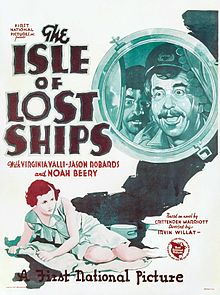The Isle of Lost Ships (1929 film)
| The Isle of Lost Ships | |
|---|---|
 | |
| Directed by | Irvin Willat |
| Written by | Fred Myton (scenario, dialogue, titles) Paul Perez (dialogue, titles) |
| Based on | The Isle of Dead Ships by Crittenden Marriott |
| Produced by | Richard A. Rowland |
| Starring | Jason Robards Sr. Virginia Valli Noah Beery Sr. |
| Cinematography | Sol Polito |
| Edited by | John Rawlins |
| Music by | Cecil Copping Alois Reiser |
Production company | |
| Distributed by | Warner Bros. |
Release date |
|
Running time | 9 reels; 7,576 |
| Country | United States |
| Languages | Sound (All-Talking) English |
The Isle of Lost Ships is an all-talking 1929 sound film. The picture was produced by Richard A. Rowland and distributed by Warner Bros. Irvin Willat was the director with Jason Robards Sr., Virginia Valli and Noah Beery Sr. in the leads. It is based on the 1909 novel The Isle of Dead Ships by Crittenden Marriott, and is also a remake of Maurice Tourneur's now lost 1923 classic of the same name. A mute copy of this film is preserved at the Library of Congress.[1][2][3][4][5] The Vitaphone discs which contain the soundtrack to the film are currently lost. An almost complete copy of the sound version of the film survives (reel four is missing) at the Eye Filmmuseum archive with an estimated running time of 55:58.
Plot
[edit]This article needs a plot summary. (December 2023) |
Cast
[edit]- Jason Robards Sr. as Frank Howard
- Virginia Valli as Dorothy Whitlock/Renwick
- Noah Beery Sr. as Captain Peter Forbes
- Clarissa Selwynne as Aunt Emma/Mrs. Renwick
- Robert Emmett O'Connor as Jackson
- Harry Cording as Gallagher
- Margaret Fielding as Mrs. Gallagher
- Kathrin Clare Ward as Mother Joyce/Burke
- Robert Homans as Mr. Burke
- Jack Ackroyd as Harry
- Sam Baker as himself
Music
[edit]The film featured a theme song entitled "Ship Of My Dreams" which was composed by George W. Meyer and Al Bryan.
Critical reception
[edit]A contemporary review in Variety reported that "the originality of the story [...] shares honors with the weird effect established by sets and the camera angles at which they are focused," that "the sets and atmosphere [...] keep an audience ever interested and tense," and described the scene in which the character Howard is "shot through a torpedo tube" as sufficiently quick and active that it "helps lessen the impossible."[6] A contemporary review of the film in The New York Times reported that "the weird story is the strongest point and the acting negligible," that "[t]his queer tale, while not particularly helped by the addition of sound, appears as a relief from the musical films and those audible photoplays in which dialogue holds the centre of the screen," that the character Howard "not only knows all about ships, radios and women, but who also can man a submarine and teach a crew its operation in three minutes," and that "Virginia Valli does not do much more than scream a little now and then."[7]
See also
[edit]- List of early sound feature films (1926–1929)
- List of early Warner Bros. sound and talking features
- The Lost Continent, 1968 film also set in the Sargasso Sea.
References
[edit]- ^ The Isle of Lost Ships at silentera.com
- ^ The American Film Institute Catalog Feature Films: 1921-30 by The American Film Institute, c.1971
- ^ The AFI Catalog of Feature Films:..The Isle of Lost Ships
- ^ Catalog of Holdings The American Film Institute Collection and The United Artists Collection at The Library of Congress (<-book title) page 90 by The American Film Institute, c.1978
- ^ 1957 MOVIES FROM AAP Warner Bros Features & Cartoons SALES BOOK DIRECTED AT TV
- ^ "Isle of Lost Ships (all dialog)". Internet Archive. Retrieved December 14, 2022.
- ^ "Sargasso Sea in Sound; Isle of Lost Ships Produced Again as a Talking Picture". The New York Times. October 26, 1929. Retrieved December 14, 2022.
External links
[edit]- The Isle of Lost Ships at IMDb
- The Isle of Lost Ships at the TCM Movie Database
- German language release poster
- 1929 films
- American silent feature films
- Films directed by Irvin Willat
- Films based on American novels
- Remakes of American films
- 1929 drama films
- American black-and-white films
- Transitional sound drama films
- Films about survivors of seafaring accidents or incidents
- American drama films
- 1920s American films
- Silent American drama films
- Silent adventure films
- 1920s English-language films
- English-language drama films
- 1920s silent drama film stubs
